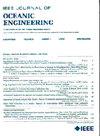HG2former: HSV-Gamma Guided Transformers for Efficient Underwater Image Enhancement
IF 5.3
2区 工程技术
Q1 ENGINEERING, CIVIL
引用次数: 0
Abstract
Due to optical phenomena, such as the absorption and scattering of light in underwater environments, underwater images often suffer from degradation in color, contrast, clarity, and noise. Existing deep learning-based methods for underwater image enhancement typically learn a direct mapping from low-quality to high-quality underwater images, without fully considering the mapping of local luminance, chrominance, and contrast features. In this article, we propose a transformer model guided hue, saturation, value (HSV) and gamma correction for underwater image enhancement. The HG2former combines the HSV color model and gamma correction techniques to isolate the three fundamental characteristics of color, providing rich, differentiated enhancement for both color and contrast in underwater images. In addition, nonlinear gamma correction adaptively adjusts the brightness and contrast of images, addressing issues of visibility reduction and color distortion in underwater imaging. Furthermore, we introduce a meticulously designed encoder–decoder structure, along with an improved multihead self-attention module, to capture the spatial distribution patterns of underwater images while modeling both local and long-range dependencies. Extensive experimental results on multiple data sets demonstrate that the proposed HG2former outperforms other state-of-the-art methods.HG2former:用于高效水下图像增强的HSV-Gamma引导变压器
由于水下环境中光的吸收和散射等光学现象,水下图像通常会出现色彩、对比度、清晰度和噪点下降等问题。现有的基于深度学习的水下图像增强方法通常是直接学习从低质量水下图像到高质量水下图像的映射,而没有充分考虑局部亮度、色度和对比度特征的映射。在本文中,我们提出了一种用于水下图像增强的变换器模型,它以色调、饱和度、值(HSV)和伽玛校正为指导。HG2former 结合了 HSV 色彩模型和伽玛校正技术,分离出色彩的三个基本特征,为水下图像的色彩和对比度提供了丰富、差异化的增强效果。此外,非线性伽马校正还能自适应地调整图像的亮度和对比度,解决水下成像中能见度降低和色彩失真的问题。此外,我们还引入了精心设计的编码器-解码器结构,以及改进的多头自注意模块,以捕捉水下图像的空间分布模式,同时模拟局部和长程依赖关系。在多个数据集上的广泛实验结果表明,所提出的 HG2former 优于其他最先进的方法。
本文章由计算机程序翻译,如有差异,请以英文原文为准。
求助全文
约1分钟内获得全文
求助全文
来源期刊

IEEE Journal of Oceanic Engineering
工程技术-工程:大洋
CiteScore
9.60
自引率
12.20%
发文量
86
审稿时长
12 months
期刊介绍:
The IEEE Journal of Oceanic Engineering (ISSN 0364-9059) is the online-only quarterly publication of the IEEE Oceanic Engineering Society (IEEE OES). The scope of the Journal is the field of interest of the IEEE OES, which encompasses all aspects of science, engineering, and technology that address research, development, and operations pertaining to all bodies of water. This includes the creation of new capabilities and technologies from concept design through prototypes, testing, and operational systems to sense, explore, understand, develop, use, and responsibly manage natural resources.
 求助内容:
求助内容: 应助结果提醒方式:
应助结果提醒方式:


